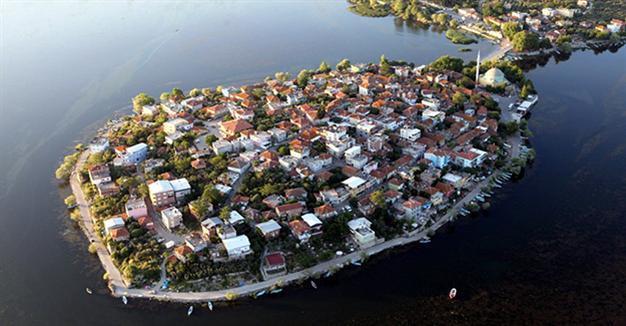Excavations start at Turkey’s ‘Little Venice’
BURSA – Anadolu Agency

AA photo
Archaeological excavations have started in an area called “Little Venice,” which dates back some 2,300 years, in the Nilüfer district’s Gölyazı neighborhood in the northwestern province of Bursa.In a written statement, Nilüfer Mayor Mustafa Bozbey said the history of Gölyazı would be revealed when the works were completed.
Within the scope of a common protocol signed with the Culture and Tourism Ministry’s General Directorate of Cultural Heritage and Museums, preparations for archaeological excavations have been finished, said the mayor.
“First of all, works have started on Kız [Girl] Island, where the Temple of Apollonia is situated. The island, which was covered by dense plants, is being cleaned by the staff of the Nilüfer Municipality Department of Parks and Gardens. After the cleaning process, Kız Island will be opened to tourism,” he said.
Bozbey said they had also initiated excavations in the necropolis area situated at the entrance of the ancient city of Apollonia ad Rhyndacum, and continued:
“We will do our best to reveal a history of 2,300 years in Gölyazı. The Temple of Apollonia on Kız Island almost disappeared because of long-time negligence. With the permission of the Bursa Governor’s Office, we have started works to clean the area. If we find traces of the temple, we will make a detailed project and offer it to future generations. We get support from Uludağ University Archaeology Department head Professor Mustafa Şahin and various institutes. If we reveal the history in Gölyazı, we will create an important tourism environment in Bursa. We will meet all financial costs for the works. When the work on Kız Island is done, there will be more boat tours. This place will be more attractive with planned accommodation units. Excavations have also started here for a 3,000-person capacity amphitheater.”
The mayor added that in addition to archaeological works, they would also initiate projects to revive social activities in Gölyazı.
“We have a surprise ‘lake bird’ and it will be on the lake soon. Our people will meet this service, too.”
Being the oldest settlement in Nilüfer and full of historical ruins, the ancient city of Apollonia, today’s Gölyazı, was claimed to be established in the 4th century B.C., and mentioned in resources from the 1st century B.C.
The city, which was initially attached to the Bithynia Prelacy during the Byzantine period, afterwards was attached to Nicomedia (İzmit) and the Kios (Gemlik) Prelacy. In this period the city was named Theotokia.
When the Ottomans won the Bafeum War in 1302, they took refuge in Lopadion and came before Apollonia ad Ryndacum for the first time. They stepped back when there was a surrender agreement with the landlord and only captured the Alyos Island within the lake. The son of Aygutalp, who was a fellow soldier of Osman Gazi, conquered the island and as a result the connection between Apollonia ad Ryndacum with Lopadion and thus with the Byzantines was lost.
The name Apolyont was changed to Gölyazı in the republican period.
















